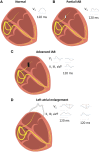Electrophysiological Mechanisms of Bayés Syndrome: Insights from Clinical and Mouse Studies
- PMID: 27303306
- PMCID: PMC4886053
- DOI: 10.3389/fphys.2016.00188
Electrophysiological Mechanisms of Bayés Syndrome: Insights from Clinical and Mouse Studies
Abstract
Bayés syndrome is an under-recognized clinical condition characterized by inter-atrial block (IAB). This is defined electrocardiographically as P-wave duration > 120 ms and can be categorized into first, second and third degree IAB. It can be caused by inflammatory conditions such as systemic sclerosis and rheumatoid arthritis, abnormal protein deposition in cardiac amyloidosis, or neoplastic processes invading the inter-atrial conduction system, such as primary cardiac lymphoma. It may arise transiently during volume overload, autonomic dysfunction or electrolyte disturbances from vomiting. In other patients without an obvious cause, the predisposing factors are diabetes mellitus, hypertensive heart disease, and hypercholesterolemia. IAB has a strong association with atrial arrhythmogenesis, left atrial enlargement (LAE), and electro-mechanical discordance, increasing the risk of cerebrovascular accidents as well as myocardial and mesenteric ischemia. The aim of this review article is to synthesize experimental evidence on the pathogenesis of IAB and its underlying molecular mechanisms. Current medical therapies include anti-fibrotic, anti-arrhythmic and anti-coagulation agents, whereas interventional options include atrial resynchronization therapy by single or multisite pacing. Future studies will be needed to elucidate the significance of the link between IAB and atrial tachyarrhythmias in patients with different underlying etiologies and optimize the management options in these populations.
Keywords: Bayés syndrome; conduction; electrophysiological remodeling; inter-atrial block; intra-atrial block; structural remodeling.
Figures




References
-
- Acar G., Sayarlioglu M., Akcay A., Sokmen A., Sokmen G., Yalcintas S., et al. . (2009). Evaluation of atrial electromechanical delay and left atrial mechanical functions in patients with rheumatoid arthritis. Turk Kardiyol. Dern. Ars. 37, 447–453. - PubMed
Publication types
LinkOut - more resources
Full Text Sources
Other Literature Sources

